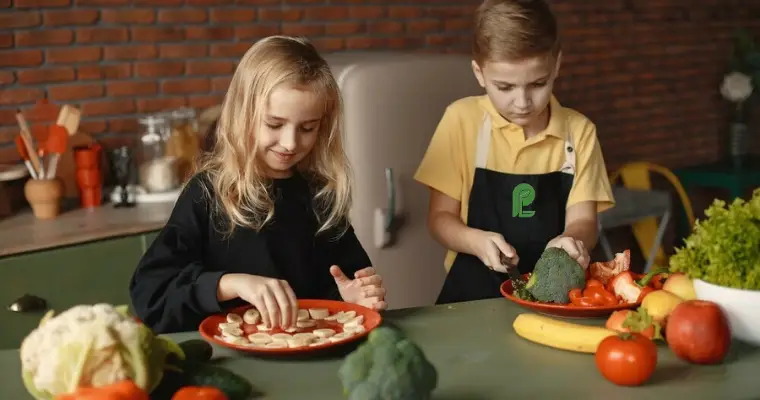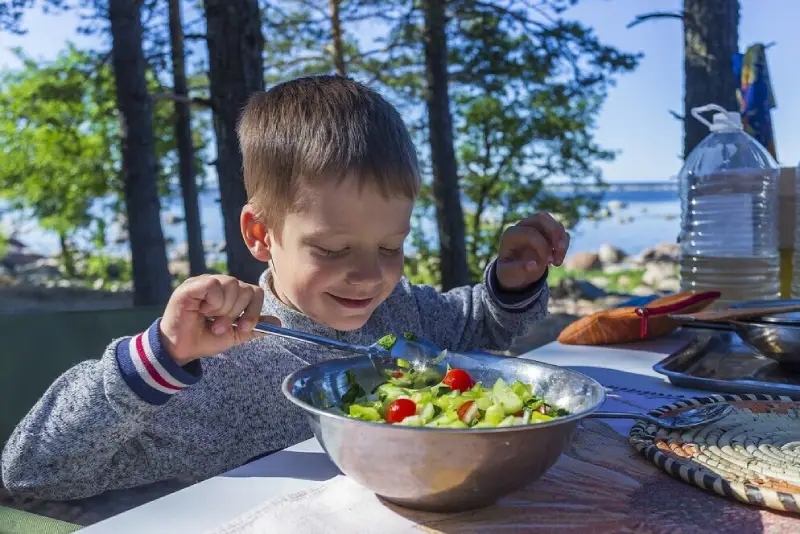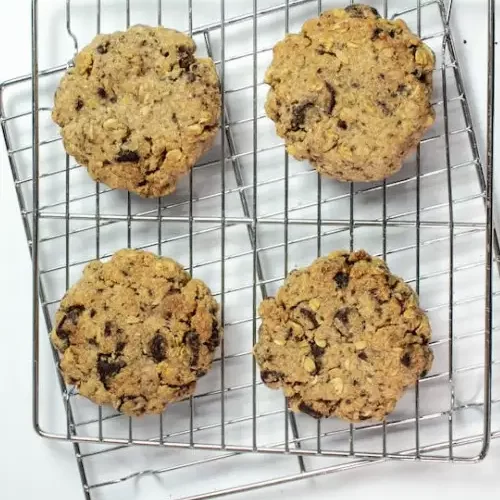Nurturing Young Palates

In this post, we will explore Nurturing Young Palates and the advantages, potential challenges, and strategies for implementing a Whole Food Plant Based diet for kids.
Instilling healthy eating habits in children is a priority for many Health-conscious parents. A Whole Food Plant-Based diet offers many benefits, promoting optimal growth, development, and long-term health.
However, navigating the world of plant-based lifestyle with kids, especially picky eaters, can be challenging.
Empowering you to foster a nutritious and enjoyable eating environment. Educating yourself about the myths and misunderstandings about a plant-based only lifestyle.
So, Let’s begin by highlighting the positive health benefits associated with a WFPB diet for children.
Positive Health Benefits of WFPB Diet for Kids
Essential Nutrients:
A well-planned WFPB diet provides children with a wide range of essential nutrients, including vitamins, minerals, antioxidants, and dietary fiber. These nutrients support optimal growth, development, immune function, and overall health.
Disease Prevention:
Plant-based diets have been linked to a reduced risk of obesity, type 2 diabetes, cardiovascular diseases, and certain types of cancer. Therefore, by nourishing young bodies with nutrient-dense plant foods, you lay the foundation for a healthier future.
Improved Gut Health:
Specifically, a fiber-rich nature of a WFPB diet promotes a healthy gut microbiome in children. A balanced gut microbiome contributes to improved digestion, enhanced nutrient absorption, and a strengthened immune system.
Taste the Colors of Health
In this engaging nutrition video session for children, Maggie Neola, RD, explains how incorporating a variety of colorful foods into our diet can boost our health!
Despite the numerous benefits mentioned, introducing a WFPB diet to children, particularly picky eaters, may pose some challenges.
Let’s explore these challenges and strategies for overcoming them.
Challenges and Strategies for Nurturing Young Palates
Picky Eating Behavior:
Many children exhibit picky eating tendencies, which can make it challenging to introduce new foods. To tackle this, involve children in meal planning, shopping, and food preparation.
Furthermore, offer a variety of plant-based options and encourage gradual exposure to new flavors and textures.
Nutritional Adequacy:
Ensuring children meet their nutritional needs while following a WFPB diet is crucial.
Pay attention to key nutrients such as protein, iron, calcium, vitamin D, and vitamin B12. Include plant-based protein sources like legumes, tofu, tempeh, and quinoa. Incorporate plant-based milk alternatives and consider supplementation for vitamin B12 if necessary.
Reach out for support when needed, from your trusted health professional for personalized advice.
Social Pressures:
Children may face social challenges when adhering to a WFPB diet, such as limited options at school or social gatherings.
Communication is key. Educate teachers, friends, and family members about the dietary choices you’ve made and discuss alternatives or options that align with your child’s needs.
Now that we’ve explored the challenges, let’s focus on practical tips for making whole food plant-based eating enjoyable for kids.

Practical Tips for Plant Powered Kids
Get Creative with Presentation:
Make meals visually appealing by using colorful fruits and vegetables, creating fun shapes, and arranging food in creative ways.
Encourage children to participate in food art or create their own plant-based dishes.
Incorporate Familiar Flavors:
Transitioning to a plant-based diet can be easier by incorporating familiar flavors. For example, use plant-based alternatives like lentil or black bean burgers, vegetable-based pasta sauces, or fruit-based desserts.
Encourage Food Exploration:
Introduce new foods gradually and encourage children to explore different flavors, textures, and cooking methods. Offer taste tests, involve them in grocery shopping and local farmers market, let them choose new fruits or vegetables to try.
Family Meals and Role Modeling:
Set a positive example by enjoying family meals together. Children are more likely to try new foods when they see their parents or siblings eating them.
Make mealtimes enjoyable and create a relaxed electronic free atmosphere.
Summary
Nurturing Young Palates with a Whole Food Plant-Based diet lays the foundation for a lifetime of health and well-being.
Although challenges may arise, they can be overcome with patience, creativity, and a positive attitude.
Remember, every child is unique, and it’s essential to respect their individual preferences and needs while promoting a varied and nutrient-dense plant-based diet.
With your guidance, children can develop a love for wholesome, plant-based foods that will serve them well throughout their lives.
Let’s get cooking!
Here are some examples of simple and kid-friendly Whole Food Plant-Based recipes, including savory options and one sweet treat.
These recipes are designed to be easy to prepare and can be made in under 60 minutes or made ahead of time and reheated.
Chickpea Nuggets with Baked Sweet Potato Fries
Ingredients:
- 1 can chickpeas, drained and rinsed
- 1/2 cup whole wheat breadcrumbs
- 2 tablespoons nutritional yeast
- 1 teaspoon garlic powder
- 1/2 teaspoon paprika
- 1/4 teaspoon onion powder
- Salt and pepper to taste
- 2 medium sweet potatoes, cut into fries
- 1 tablespoon cornstarch
Instructions:
- Preheat the oven to 400°F (200°C) and line a baking sheet with parchment paper.
- In a food processor, combine the chickpeas, breadcrumbs, nutritional yeast, garlic powder, paprika, onion powder, salt, and pepper. Pulse until well combined and the mixture holds together.
- Shape the mixture into small nugget shapes and place them on one side of the prepared baking sheet.
- Toss the sweet potato fries with cornstarch to coat evenly and place them on the other side of the baking sheet.
- Bake for 20-25 minutes, flipping the nuggets and fries halfway through, until golden brown and crispy.
- Serve the chickpea nuggets with baked sweet potato fries for a delicious and nutritious meal.
Lentil Sloppy Joes
Ingredients:
- 1 cup cooked green or brown lentils
- 1 small onion, diced
- 1 small bell pepper, diced
- 2 cloves garlic, minced
- 1 cup tomato sauce
- 2 tablespoons tomato paste
- 2 tablespoons maple syrup
- 1 tablespoon low-sodium soy sauce or tamari
- 1 teaspoon chili powder
- Salt and pepper to taste
- Whole grain hamburger buns or lettuce wraps
Instructions:
- In a large skillet, sauté the onion, bell pepper, and garlic until softened.
- Add the cooked lentils, tomato sauce, tomato paste, maple syrup, soy sauce, chili powder, salt, and pepper to the skillet. Stir well to combine.
- Simmer the mixture over low heat for 15-20 minutes, allowing the flavors to meld together.
- Serve the lentil sloppy joe mixture on whole grain hamburger buns or lettuce wraps for a hearty and satisfying meal.

Easy Oatmeal Banana Cookies
Equipment
- 1 Mixing Bowl
- 1 Baking Sheet Lined with Parchment Paper.
Ingredients
Main Ingredients
- 2 Large Ripe Bananas Mashed Or 4 Ripe Apple Bananas
- 1 1/2 Cups Organic Rolled Oats
- 1/3 Cup Organic Rasins Or Dates, Dried Cranberries
- 1/3 Cup Organic Pecans or Walnuts Chopped
- 1 TSP Ground Cinnamon
- 1/8 TSP Ground Cloves Optional
- 1 TSP Pure Vanilla Extract or Powder
Instructions
Instructions
- Preheat your oven to 350°F(175°C) and line a baking sheet with parchment paper.
- In a mixing bowl, Mash the bananas till smooth leaving small chunks.
- Then add oats, raisins or cranberries, chopped nuts of choice, cinnamon, cloves and vanilla extract. Mix until well combined.
- Drop Spoonfuls of the mixture onto the prepared baking sheet, shaping them into round cookies.
- Bake for 15-20 minutes or until golden brown.
- Allow the cookies to cool 5 minutes before enjoying.
Notes
Additional Recipe Details:
These cookies are entirely plant-based, containing no animal products, added oils, or refined sugars. They are a great source of dietary fiber from the oats and natural sugars from the ripe bananas. You can customize the recipe by adding ingredients like different nuts, dates, dried fruit, or non-dairy chocolate chips for added flavor and textures.Storage:
Store the cookies in an airtight container at room temperature for a few days or in the refrigerator for longer freshness. They can also be frozen for more extended storage.You can find more WFPB recipes here.>Recipe Index – Plantaful Life<
Conclusion
In closing, nurturing your child’s palate with a Whole Food Plant-Based lifestyle is a gift that can positively impact their long-term health and well-being.
By implementing practical tips, involving children in the process, and fostering a positive and supportive environment, you can instill healthy eating habits that will serve them throughout their lives.
Welcome the journey and rejoice in every stride towards a plate brimming with plant-based goodness, recognizing that you’re nourishing their bodies and molding their future.
Remember, you can sow the seeds of health and wellness now, ensuring a vibrant future for generations to come.
Please leave us a comment if you are looking for support on your wellness journey or contact us directly if you have any questions.
Subscribe now to get a user-friendly “Get Started” guide featuring 12 tips for transitioning to a WFPB diet.
Cheers,
Plantaful Life Team
Disclaimer: The information shared in this blog post and on our website is for educational and informational purposes only. We are here to inspire and support you on your plant-based journey. However, always prioritize your health and consult with your trusted healthcare provider for personalized advice. By using our website, you acknowledge and agree that you have read and understood this medical disclaimer. Additionally, you acknowledge the significance of seeking professional medical advice for your specific health needs.
References:
Myths About Plant-Based Lifestyle – Plantaful Life
Raising Children On A Plant-based Diet – Naked Food Magazine